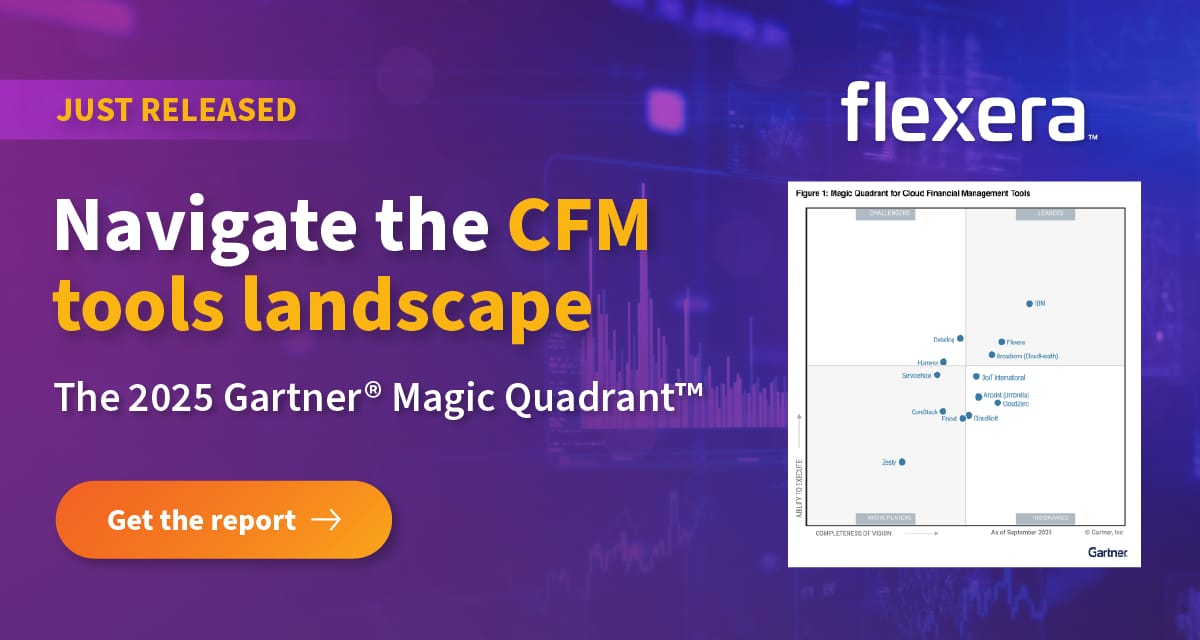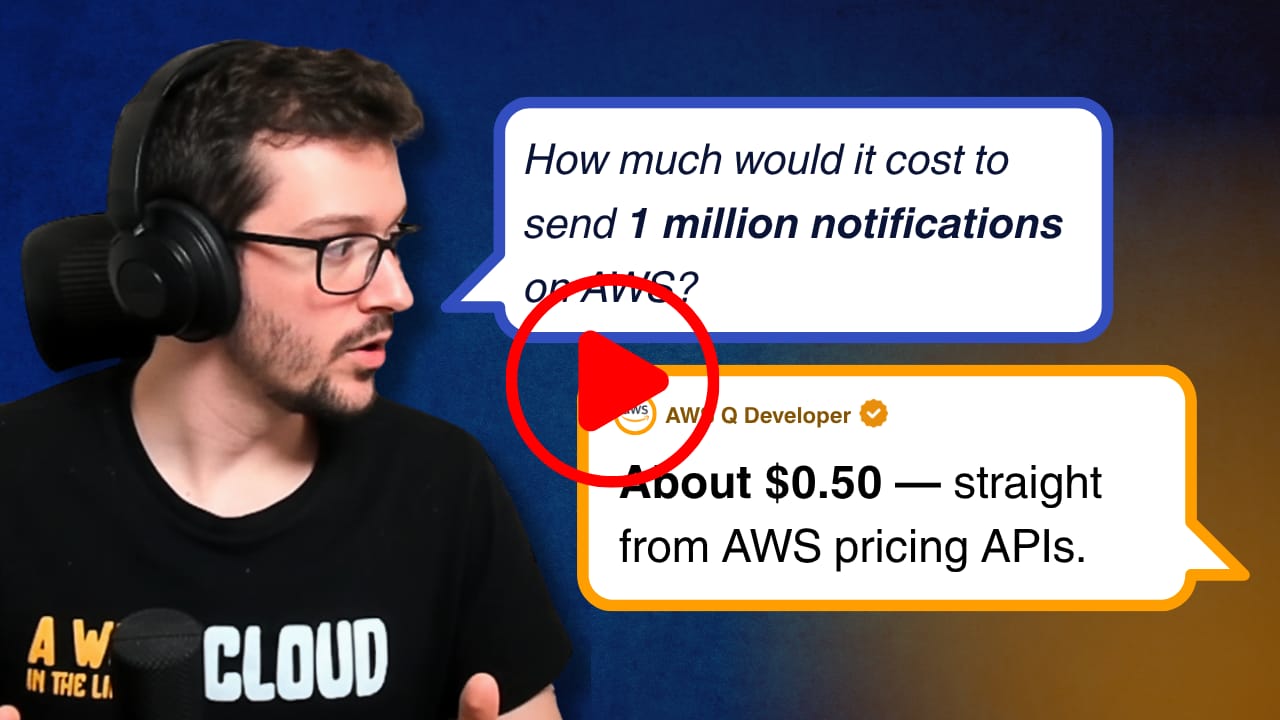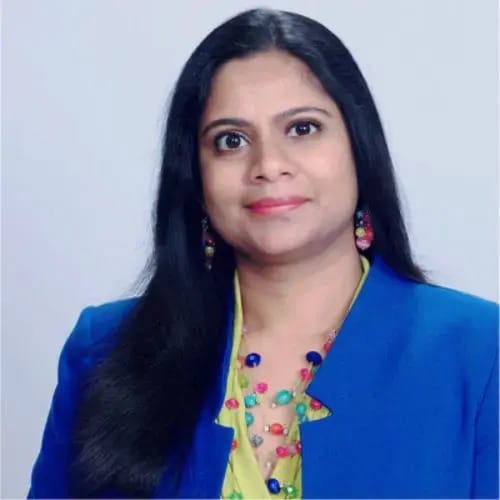TOGETHER WITH FLEXERA
How to choose CFM tools: 2025 Gartner® Magic Quadrant™
Surprise bills. Inaccurate allocation. Wasted commitments. Most FinOps tools handle part of the challenge—but few deliver true end-to-end financial visibility across cloud, SaaS and on-premises environments.
The newly released 2025 Gartner® Magic Quadrant™ for CFM tools evaluated 13 vendors to identify which platforms deliver the full scope of capabilities enterprises need. With the FinOps market projected to hit $38.33B by 2034, choosing the right platform is critical.
Flexera was positioned as a Leader, recognized for its unique total cost visibility through ITAM integration—spanning cloud infrastructure, software licensing, and on-premises environments—plus multi-cloud intelligence across all major providers and advanced scenario modeling that empowers confident hybrid transformation decisions.
Make informed CFM decisions backed by independent analysis.
FINOPS FOR AI
CIO Lessons on AI Cost Overrun
Wipro's Global CIO Kenny Kesar has learned some hard lessons about AI costs that every business leader should know.
After taking the helm in April, Kesar watched his company's AI bills spiral out of control. "We've seen exorbitant bills come out of applications that did or should be nothing," he told CIO Dive.
The problem wasn't just about using too much computing power. Kesar found that many teams were using AI simply because they could, not because they needed to. "There's a lot of AI used for the sake of AI, and that is where it kills the economics," he explained.
Here's what went wrong and how they fixed it:
The Cost Trap: Without proper planning, AI projects can cost five to 10 times more than expected. Cloud bills that should have been thousands turned into hundreds of thousands of dollars.
Process Matters: Kesar discovered that "AI without the right process orchestration is a very expensive experiment." Teams need clear workflows before adding AI to the mix.
Smart Choices: The company now questions every AI use case. If a simpler solution can do the job, they skip the AI altogether.
Cloud Strategy: Instead of buying expensive GPU infrastructure upfront, Wipro uses cloud services to test ideas first. This lets them scale up only when they know something works.
The lesson is clear: AI can transform your business, but only if you control the costs from day one.
CLOUD PROVIDERS
AWS Q Developer is now a FinOps Tool
AWS
Amazon Q Developer can now answer pricing and cost-estimate questions
AWS Marketplace supports EUR/GBP/AUD/JPY for usage-based private offers
AWS Marketplace increases pricing dimensions
Amazon OpenSearch Ingestion adds batch AI inference
Self-service invoice correction
Automatic quota management for AWS Service Quotas
New compute-optimized EC2 C8i and C8i-flex instances
Amazon EKS and EKS Distro support Kubernetes 1.34
Amazon RDS for Db2 supports native database-level backups
Multi-source custom billing views
Microsoft Azure
Retirement notice — Azure Cache for Redis retiring in September 2028
Google Cloud
BigQuery updates: daily on-demand limits, reservations, transfers, and job priorities
FinOps EVENTS
Event: The Hybrid FinOps Advantage
FinOps has expanded far beyond public cloud. Managing costs across data centers, AWS, Azure, SaaS, and AI workloads separately prevents total cost visibility and missed savings.
Discover how FinOps 2.0 strategies deliver comprehensive optimization across your entire technology portfolio.
You'll Learn How To:
Achieve total cost visibility across data centers, multi-cloud, SaaS, and AI infrastructure
Optimize the complete technology stack with unified intelligence and automation
Break down silos between FinOps, ITAM, procurement, and engineering teams
Speakers
Jeremy Chaplin, Gerhard Behr & Victor Garcia
November 13th - 6:00 PM CEST / 10AM EST
CLOUD
The Cloud Power Shift: A Chaos or a Hidden Opportunity?
Cloud changed who has power. It didn't just change technology. It changed how companies work.
People say cloud is expensive. It can be, but only if you use it like an old computer room. When you compare your old setup to cloud, you forget about half the real costs. Nobody counted server repairs, cables, electricity, cooling, network work, checks, or the people fixing everything.
Many companies make this mistake. They build internal tools that wrap the cloud's features in red tape. It feels safer. It feels familiar. But it's fake control. Nobody wins.
Engineers lose flexibility because they have to work through layers of internal paperwork.
Procurement still can't negotiate because there's no hardware deal to discuss.
Finance still can't predict because costs arrive too late. Business leaders still can't steer because spending and results move separately.
The control that everyone wanted never comes back. Same cost problems, same coordination problems, same confusion. Just running on newer equipment.
If you're going to do that, you might as well keep your old setup. At least there, procurement can negotiate, finance can plan, and engineers know the limits.
If you have money to build your own "internal cloud screen," don't. Use that money to build practices that help you understand cloud costs. Train your people. Build shared understanding. Cloud gives you a blank canvas, but the mistake is painting the old walls on it.
📺 PODCAST
Is your AI Initiative Worth It?
Learn the top FinOps strategies, KPIs, and quick wins to optimize AI workloads, cut hidden costs, and maximize business value. Excellent advice given by Erik Peterson. Should you run that AI workload in the first place? Learn the answer in the podcast.
Check all about CloudZero at https://www.cloudzero.com
OPENSOURCE
Building FinOps With k0rdent Open Source
A new open-source solution called k0rdent and its FinOps component (KOF) aims to solve this problem. k0rdent acts like a control center for managing hundreds or thousands of Kubernetes clusters. KOF sits on top of it and collects data from all these clusters in a standard way.
The FinOps Agent is the star of the show. It uses a special AI model called TOTO that can predict future costs without needing months of training. This agent does four main things:
It collects data from your existing monitoring systems. It predicts what your costs will look like in the future. It finds resources that are sitting idle and costing you money. It gives you specific recommendations with dollar amounts you can save.
When the agent finds waste, it doesn't just say "you have idle resources." Instead, it tells you something like: "Remove this specific server and save $7.82 over the next week." For bigger companies with hundreds of clusters, these small savings add up to thousands of dollars.
The whole system plugs into tools teams already use, like Grafana dashboards and standard APIs. You don't need to rebuild your entire monitoring setup.
AZURE
Managing Azure Management Groups for Cost Allocation
Azure Management Groups offer a smart way to organize your cloud costs without spending extra money. A Management Group is like a big container that holds multiple Azure subscriptions under one roof.
These groups do more than just organize costs - they also help control who can access what and make sure everyone follows the same rules across all subscriptions in the group.
Your main tenant sits at the top, then Management Groups, followed by subscriptions, resource groups, and finally your actual resources. You can even create Management Groups inside other Management Groups, making smaller and more specific divisions as needed.
The best part is that permissions flow downward automatically. If you give someone access to a Management Group, they get the same access to everything inside it - all the subscriptions, resource groups, and resources.
For cost tracking, Management Groups work best when you use them for big categories like different departments (Marketing, Finance, Sales) or different environments (Development, Production, Testing).
🎖️ MENTION OF HONOUR
Your FinOps Guide to AWS re:Invent 2025
Two main sessions will cover the latest updates. COP202 focuses on cost optimization and features a special guest from Delta Airlines. COP203 covers cost management tools and includes experts from The Duckbill Group and FinOps Foundation.
The chalk talks let you discuss topics like using AI for FinOps and setting up cost governance with smaller groups. These sessions cover practical topics like estimating costs and optimizing resources.
If you learn better by doing, the workshops and builder sessions are perfect. You'll work on real problems like tracking costs for container workloads and building cost dashboards. Just remember to bring your laptop for these sessions.
The FinOps Foundation is hosting a full day of activities at the Venetian Hotel. This includes watching keynotes together, having lunch, and connecting with other professionals who manage cloud costs.
Professional Spotlight
Deepika Prabhakar
Customer Oriented FinOps
Deepika was one of the earlier supporters of the Summit. Looking forward to her talk with Haley on the event!
That’s all for this week. See you next Sunday!
2 Days of a Full FinOps Experience
The FinOps Event You Can’t Miss (And it’s FREE)
Move from quick fixes to strategic planning
Strengthen your financial metrics
Use AI to optimize costs
This is the last big FinOps event of 2025, showcasing proven strategies from companies handling large cloud budgets.
October 23 & 24, 2025
3:00 PM - 9:00 PM CEST / 9:00 AM - 3:00 PM EST
Limited seats available
FinOps for Everyone!











